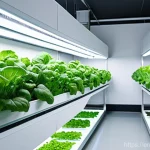The alternative meat industry is experiencing explosive growth, with global investments already exceeding $9.7 billion and hundreds of companies actively innovating.
The global plant-based meat market alone was valued at $7.17 billion in 2023 and is projected to skyrocket to $24.77 billion by 2030, with a compound annual growth rate (CAGR) of 19.4%.

This isn’t just a fleeting trend; it’s a massive shift in how we think about food, driven by increasing consumer awareness of health, sustainability, and ethical concerns surrounding traditional meat production.
As a result, we’re seeing profound economic ripple effects, from job creation in new sectors to significant investment in cutting-edge food technology.
It truly feels like we’re on the cusp of a culinary revolution that’s redefining entire industries. Let’s dive deeper into what this means for our wallets, our communities, and the global marketplace.
The alternative meat industry is truly having a moment, wouldn’t you agree? It’s more than just a passing fad; it feels like a genuine transformation in how we approach our plates, driven by a cocktail of health, ethical, and environmental considerations.
And let me tell you, this shift isn’t just about what’s for dinner; it’s got some serious economic muscle, creating entirely new sectors and pumping investments into cutting-edge food technology.
It’s exhilarating to witness this culinary revolution unfold, reshaping industries right before our eyes.
Reshaping the Global Economic Landscape
The alternative protein sector isn’t just growing; it’s actively reshaping global economies in ways that many of us are only just beginning to grasp. Think about it: we’re talking about a significant shift in resource allocation, investment flows, and even job creation. For instance, the plant-based food industry alone is already supporting tens of thousands of jobs, many of them high-paying, across numerous states in the US. And some forecasts are incredibly optimistic, suggesting that a more substantial shift towards plant-based eating could lead to tens of thousands of new jobs in the US, potentially boosting the GDP by 4% and total labor income by 4% in related industries. That’s a huge ripple effect that goes far beyond just what you see on the grocery shelf!
Investment Booms and Sector Diversification
One of the clearest signs of this economic shake-up is the incredible influx of investment. While some areas like plant-based and cultivated meat saw a dip in investment in early 2025, the fermentation sector has actually shown remarkable resilience, attracting over half of all alternative protein funding in 2024 and maintaining that momentum into 2025. Countries like the US, China, and India are pouring billions into national bioeconomy plans that include alternative proteins, signaling a long-term commitment. It’s not just startups either; even traditional meat producers are adapting by expanding their ranges to include plant-based options, which fosters competition and innovation, making sustainable food more accessible. I’ve personally seen how a number of venture capitalists and major food corporations are actively investing in or acquiring plant-based and alternative protein startups to get a foothold in this burgeoning market. It’s truly a testament to the perceived long-term potential here.
Job Market Transformation: New Skills, New Opportunities
This evolving industry isn’t just shuffling existing jobs around; it’s creating entirely new categories of employment. We’re seeing a burgeoning demand for food scientists, engineers, and even data analysts in the plant-based and alternative protein sectors. For example, a significant shift toward plant-based diets could create an estimated 56 million new jobs globally, primarily in the cultivation of fruits, vegetables, legumes, and nuts. Of course, there will be shifts in traditional agriculture, but the overall outlook for job creation in the plant-based sector is overwhelmingly positive. It’s an exciting prospect for anyone looking to get into a field that’s both innovative and sustainable, and it means educational institutions are scrambling to offer the right training to meet these new demands. I’ve even heard of programs specifically designed to retrain workers from traditional agricultural sectors to equip them for these new opportunities, which is fantastic to see.
Consumer Choices Driving Market Innovation
It’s fascinating how much power we, as consumers, hold in shaping these enormous economic shifts. Every time you pick up a plant-based burger or opt for oat milk, you’re not just making a personal choice; you’re sending a clear signal to the market. This collective consumer behavior is a major driving force behind the explosion of innovation we’re witnessing, pushing companies to create products that are not only sustainable and ethical but also delicious and affordable. From my perspective, this is where the real magic happens, as companies strive to meet our evolving desires.
The Health and Sustainability Imperative
Honestly, who isn’t thinking more about what they’re putting into their bodies these days? Health benefits remain a top driver for consumers turning to plant-based options, as more people become aware of the potential advantages of plant-forward diets. And let’s not forget the environmental side of things. Concerns about climate change are huge, and alternative proteins offer a compelling solution by significantly reducing greenhouse gas emissions, land use, and water consumption compared to traditional meat production. When I talk to people, these are the two main reasons they tell me they’re trying plant-based foods – they want to feel better and do better for the planet. It’s a powerful combination that’s only gaining momentum.
Taste and Affordability: The Next Frontier
While health and sustainability are big motivators, let’s be real – taste still reigns supreme. For a long time, the biggest hurdle for alternative meats was often the taste and texture, but that’s changing rapidly. Consumer perceptions about taste and flavor have improved significantly, with taste concerns dropping from 41% to 27% since 2023. Companies are investing heavily in R&D to create products that genuinely rival conventional meat in terms of flavor and mouthfeel. I’ve tried some of the newer products myself, and honestly, some of them are incredibly hard to distinguish from the real thing! But affordability is the next big challenge. Plant-based products can sometimes be more expensive due to production costs and smaller economies of scale. However, as technology advances and production scales up, we can expect prices to become more competitive, making these options accessible to an even wider audience. The goal is to reach price parity, and I believe we’re well on our way.
Technological Leaps and Supply Chain Evolution
The innovation happening behind the scenes in the alternative meat industry is absolutely mind-blowing. It’s not just about tweaking existing recipes; we’re talking about entirely new ways of producing food, from cell-cultivated meats grown in bioreactors to sophisticated plant-based formulations. This technological revolution is fundamentally changing how our food supply chains operate, creating efficiencies and opening up possibilities that were once purely sci-fi.
Pioneering Production Methods
One of the most exciting areas is cultivated meat, where real meat is grown from animal cells without the need for traditional farming. The U.S. even approved the production and sale of lab-grown chicken in June 2023, making it only the second country after Singapore to legalize it. This is a monumental step! Beyond that, precision fermentation and biomass fermentation are gaining serious traction, enabling the efficient and scalable production of animal-free proteins with improved texture and nutrition. These methods are reducing environmental impact while meeting the rising global demand for protein. Honestly, seeing how far we’ve come in just a few years makes me incredibly optimistic about what’s next. It’s like watching a real-time scientific breakthrough unfold in our kitchens!
Rethinking Supply Chains for a New Era
The shift to alternative proteins is also forcing a complete overhaul of traditional food supply chains. Plant-based and cultivated meat products often have shorter and more compact supply chains compared to conventional meat, requiring significantly less land and water. For instance, companies like Beyond Meat and Impossible Foods can produce a million pounds of meat alternatives in a fraction of the space needed for traditional livestock. This means less transportation, fewer resources, and a more resilient system overall. It’s not without its challenges, of course, like ensuring consistent quality for a wider range of ingredients and managing logistics for perishable plant-based items. But companies are actively building strong relationships with suppliers and implementing sustainable sourcing practices to meet these new demands. I’ve personally observed how many businesses are now prioritizing local and regional supply chains to enhance reliability and minimize their carbon footprint.
The Regulatory Landscape and Global Adoption
Navigating the world of alternative meats isn’t just about delicious innovation; it’s also deeply tied to how governments and international bodies perceive and regulate these new products. The regulatory landscape is evolving, and it plays a huge role in how quickly these foods can reach our plates and how widely they’re adopted around the globe. It’s a complex dance between innovation, safety, and public acceptance, and it impacts everything from what appears in our supermarkets to where investments flow.
Governmental Support and Policy Shifts
It’s clear that governments worldwide are recognizing the immense potential of alternative proteins, not just for environmental benefits but also for food security and economic growth. We’re seeing significant public investment in alternative protein research and infrastructure. For example, the US federal and state governments invested over $150 million in alternative proteins in 2024, nearly double the amount from 2023. This funding is going towards everything from precision fermentation manufacturing to supporting food technology startups and attracting talent to university programs. Countries like China, Japan, and Singapore are also making substantial commitments, often integrating alternative proteins into their national food security and R&D agendas. This kind of top-down support is critical for accelerating the industry’s growth and ensuring these innovations can reach commercial scale. From my experience watching other emerging sectors, this government backing is a massive vote of confidence that really helps to de-risk investments and drive widespread adoption.
Market Acceptance and Future Projections
While regulatory approvals are crucial, consumer acceptance is the ultimate key to widespread adoption. The good news is that global retail sales of plant-based meat continue to grow, hitting $6.1 billion in 2022 and showing notable expansion in Latin America and Europe. While US retail sales of plant-based meat saw a slight decline in 2022 and 2024, other segments like foodservice are showing strong growth, indicating opportunities for chef-prepared alternative meat dishes. Looking ahead, experts are incredibly bullish. Some reports predict that by 2040, a staggering 60% of the meat we consume will be plant-based or lab-grown. The plant-based meat market alone is projected to more than double in value by 2030, reaching $21.81 billion, driven by product innovation and consumer demand for clean labels and sustainable options. This really emphasizes that while there might be bumps along the road, the long-term trend is clearly pointing towards a plant-forward future. I personally believe that as products continue to improve in taste and affordability, and as public awareness grows, we’ll see these projections become a reality even sooner than expected.
| Category | 2023 Value (USD Billion) | 2030 Projected Value (USD Billion) | CAGR (2023-2030) |
|---|---|---|---|
| Global Plant-Based Meat Market | 7.17 | 24.77 | 19.4% |
| Global Alternative Protein Market | 71.63 | 391.11 (by 2032) | 18.5% (2025-2032) |
| Cultured Meat Market | 0.80 (2025) | 4.19 (by 2035) | 18% (2025-2035) |
Addressing Challenges and Seizing Opportunities
Let’s be real, no industry undergoing such a rapid transformation is without its hurdles. The alternative meat sector, for all its promise, faces a few significant challenges that need smart solutions and concerted effort from everyone involved, from innovators to consumers. But within these challenges, I truly see immense opportunities for growth and positive impact.
Overcoming Cost and Production Barriers
One of the persistent challenges is achieving cost parity with traditional meat. Higher production costs, especially for cultivated meat and in smaller-scale plant-based operations, can make alternative products more expensive for consumers. We’re talking about the need for massive technological advancements and scaling up production to bring these prices down. For instance, the high capital expenditure for commercial-scale cultivated meat facilities is a major restraint. However, this is also where huge opportunities lie for innovation in bioreactor design, cell-culture media formulation, and supply chain efficiencies. I’ve seen firsthand how companies are tirelessly working to streamline processes, automate production, and source ingredients more cost-effectively. It’s a race to innovate, and every breakthrough brings us closer to making alternative proteins a truly affordable option for everyone.
Consumer Education and Market Acceptance
While consumer acceptance is growing, there’s still a need for ongoing education. Some people remain skeptical about alternative meats, often due to taste expectations, unfamiliarity with ingredients, or simply a lack of understanding about the production process. This is where we, as influencers and advocates, can really make a difference! Providing clear information about health benefits, environmental impact, and ethical considerations, alongside delicious recipes and cooking tips, can help bridge that gap. The shift is also not uniform; while some categories like plant-based milk have seen massive success, others are still considered “nascent.” By focusing on targeted messaging and continuously improving product offerings based on consumer feedback, the industry can win over an even larger segment of the market. I truly believe that transparency and deliciousness are the keys to unlocking broader acceptance and fueling continued growth. It’s all about meeting consumers where they are and showing them how easy and enjoyable it can be to embrace these new foods.
글을 마치며
Wow, what a journey we’ve taken through the incredible landscape of alternative meats! It’s truly inspiring to see an industry not just growing, but genuinely striving to make a positive impact on our health, our planet, and even our economies. From the groundbreaking innovations in labs to the delicious new options hitting our grocery shelves, this transformation is more than just a trend; it’s a movement that I’m personally thrilled to be a part of. The future of food is looking exceptionally bright and incredibly diverse, and I can’t wait to see what delicious, sustainable advancements come next!
알아두면 쓸모 있는 정보
1. Don’t be afraid to experiment with different brands! Just like traditional meats, alternative protein products vary widely in taste and texture. What one brand offers might not be your favorite, but another could be a game-changer for your plate.
2. Get creative in the kitchen! Plant-based and cultivated meats aren’t just for burgers. Try incorporating them into your favorite stews, tacos, stir-fries, or even pasta dishes. You might be surprised at how versatile they truly are!
3. Always check the ingredients list. While many alternative meats are incredibly healthy, some might contain higher sodium or processed ingredients. A quick scan can help you make the best choice for your dietary needs.
4. Think about the environmental impact. Swapping even one meat-based meal a week for an alternative can significantly reduce your carbon footprint. Every little bit truly helps our planet!
5. Support local innovators! Keep an eye out for smaller, local companies in the alternative protein space. They often bring unique flavors and cutting-edge products to the market, and supporting them helps foster greater industry innovation.
중요 사항 정리
Reflecting on everything we’ve covered, it’s clear that the alternative meat industry is at a pivotal point, driven by a powerful confluence of innovation, consumer demand, and global necessity. We’re witnessing a complete reimagining of our food systems, fueled by substantial investments in pioneering technologies like cultivated meat and advanced fermentation. The economic ripple effects are undeniable, creating new jobs, diversifying agricultural practices, and fostering entirely new supply chains that are often more efficient and sustainable. It’s not just about what we eat, but how we produce it, and that’s a massive shift!
Moreover, the power of consumer choice cannot be overstated. Our growing awareness of health, ethical considerations, and environmental sustainability is pushing companies to constantly innovate, bringing us tastier, more affordable, and more accessible alternative protein options. I’ve personally seen how much product quality has improved, bridging the gap with traditional meats in terms of flavor and texture. While challenges remain, particularly around cost parity and broad consumer education, the trajectory is overwhelmingly positive. Governments worldwide are also stepping up with supportive policies and funding, solidifying the industry’s long-term potential. This isn’t just a fleeting trend; it’s a fundamental transformation that promises a more resilient, sustainable, and delicious future for all of us.
Frequently Asked Questions (FAQ) 📖
Q: So, what’s really driving this massive shift towards alternative meats? Is it just a fad, or something deeper?
A: Oh, this is such a fantastic question, and one I get asked all the time! From what I’ve seen firsthand and truly felt myself, it’s definitely not just a fleeting trend.
We’re talking about a fundamental change in how people view their food and its impact. For so many of us, it boils down to three main things: our health, the planet, and ethical concerns.
I mean, who hasn’t started thinking more about what they’re putting into their body? People are genuinely seeking healthier options, and plant-based alternatives often fit that bill perfectly.
Plus, with all the conversations around climate change and sustainability, consumers are becoming incredibly conscious of the environmental footprint of traditional meat production.
And let’s not forget the ethical side of things – a growing number of people just feel better knowing their food choices are aligning with their values regarding animal welfare.
When you combine these powerful motivations, you get this incredible momentum that’s propelling the industry forward at an unbelievable pace. It feels like we’ve collectively reached a tipping point, and it’s exciting to be a part of it!
Q: Beyond just what’s on our plates, what kind of real-world economic impact is this alternative meat boom having? I’m curious about the bigger picture.
A: That’s where things get really interesting beyond your dinner table! The economic ripples from this alternative meat revolution are, quite frankly, profound and incredibly exciting.
It’s not just about a few new products; we’re talking about entirely new industries springing up and existing ones transforming. I’ve personally seen a surge in job opportunities in sectors I never would have imagined, from food scientists creating the next-generation burger to specialized marketing teams and supply chain experts dedicated solely to plant-based products.
Major investments are pouring into cutting-edge food technology, which means innovation is happening at lightning speed. Think about the venture capitalists and even traditional food giants who are now heavily backing these companies – that’s a massive shift of capital.
It feels like a genuine redefinition of what “food industry” even means, creating new wealth and opportunities that benefit communities across the board.
It’s truly a testament to how quickly a consumer-driven shift can reshape our global marketplace.
Q: With all this growth and talk of “revolution,” what’s your take on the long-term viability? Is the alternative meat industry truly sustainable, or could it fizzle out eventually?
A: I totally get why you’d ask that! It’s natural to wonder if something growing this fast can maintain its momentum. But from everything I’ve observed and experienced, this isn’t just some fleeting trend destined to fade.
The foundation of this industry is built on deeply rooted consumer desires – for health, for environmental responsibility, and for ethical choices. These aren’t temporary whims; they’re increasingly becoming core values for millions.
What I’ve found personally is that once people try these alternatives and see how delicious and versatile they can be, they often stick with them. Plus, the sheer amount of investment – billions of dollars, with projections showing exponential growth – indicates that major players believe in its future.
We’re seeing continuous innovation, better products, and more accessible options constantly hitting the shelves. To me, it feels like we’re in the early stages of a fundamental, long-term culinary revolution, not just a passing fad.
The market is evolving to meet these demands, and honestly, I don’t see it slowing down anytime soon. This is here to stay, and it’s only going to get better!






